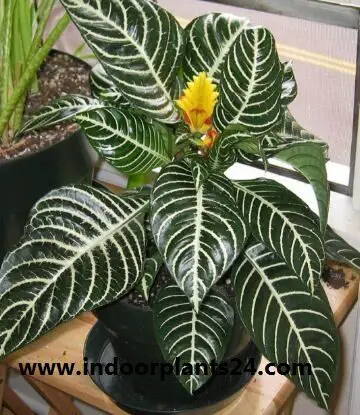01:36 One of the most attractive indoor plants, this compact aphelandra is truly a dual-purpose specimen its fabulous foliage catches the eye when the dramatic yellow bracts are absent. 
aphelandra squarrosa toxic to cats aphelandra squarrosa propagation aphelandra squarrosa plant images


In the wild it thrives in the high humidity and regular downpours of the rain forest, and it has adapted well to indoor conditions but will not flourish unless humidity is high. The stem is stout and fleshy, and the 8-10-in/20-25-cm-long leaves are broadly elliptical, dark grayish green, and heavily striped in the vein areas with silvery white.  Insignificant tubular yellow flowers peep through a much more impressive four-sided, cone-shaped spike of yellow bracts, tinged red—hence the plant’s other common name, saffron spike. To add to the pleasure the plant gives, these bracts are long-lasting, often looking good for six or seven weeks.
Insignificant tubular yellow flowers peep through a much more impressive four-sided, cone-shaped spike of yellow bracts, tinged red—hence the plant’s other common name, saffron spike. To add to the pleasure the plant gives, these bracts are long-lasting, often looking good for six or seven weeks.  Watch out for scale insects and for aphids, which are drawn to the bracts and young foliage. Falling leaves are a sign that the plant has been allowed to dry out.
Watch out for scale insects and for aphids, which are drawn to the bracts and young foliage. Falling leaves are a sign that the plant has been allowed to dry out.  Sciarid flies, or fungus gnats, can be a nuisance if the potting mixture becomes excessively wet and sour.
Sciarid flies, or fungus gnats, can be a nuisance if the potting mixture becomes excessively wet and sour.
FACT FILE
ORIGIN Brazil.
HEIGHT To 12in/30cm.
POTTING MIX Soil-based, with peat moss or leaf mold added.
REPOTTING Once a year, at any time other than the coldest winter months. Pot the plant firmly.
PROPAGATION Take tip cuttings and sideshoots in spring.
KEEPING PLANTS Plants that have flowered should be cut down to a pair of lower leaves in spring, or they will become too tall.
Aphelandra squarrosa Acanthaceae KEBRA PLANT CARE and guide
- Bright to semishaded conditions; no direct sunlight.
- Minimum winter temperature of 62°F/17°C, normal room temperature at other times.
- Water plentifully during the period of active growth. Give less water for a few weeks after flowering to allow the plant to rest, but never allow the soil to dry out completely.
- Maintain a humid atmosphere by standing the plant on moist pebbles, or plunge it into moist peat moss.
- Apply full-strength liquid fertilizer every 2 weeks from early spring to late summer.

- Share
- Share
- Share
- Share
